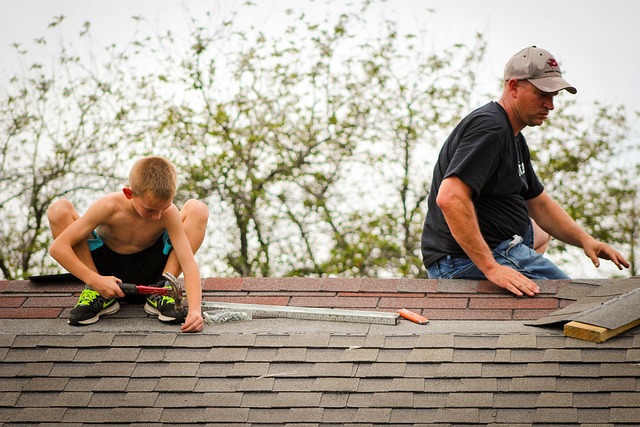Roof maintenance is critical for preserving a home's structural health and preventing costly repairs. Regular inspections are necessary to identify early signs of roofing damage like cracked shingles or missing granules, which can be exacerbated by weather exposure and aging. Homeowners should watch for water stains inside the house, indicative of potential moisture intrusion through compromised roof areas. Attic checks offer a clear view of hidden roof issues that might not be apparent from ground level. Clear gutters and downspouts are crucial to prevent water backups that could damage the roof over time. By staying vigilant, conducting regular inspections, and addressing issues promptly, homeowners can effectively manage minor roofing damage before it escalates, thereby safeguarding their homes and avoiding more extensive problems. Remember to be proactive in your roof maintenance efforts to ensure a resilient and long-lasting roof system.
Roofs are our home’s first line of defense against the elements, safeguarding both our property and our well-being. Understanding and addressing roofing damage is crucial for maintaining a secure and comfortable living environment. This article demystifies the process of inspecting your roof for damage, offering valuable insights into recognizing potential issues, conducting self-inspections, and knowing when to call in the professionals. Whether you’re a seasoned homeowner or new to managing property, this guide will equip you with the knowledge to ensure your roof remains robust against the relentless barrage of weather conditions that threaten its integrity. By staying vigilant and proactive, you can prevent minor damages from escalating into costly repairs, thus preserving your home’s structural soundness and longevity.
- Recognizing Roofing Damage: An Overview for Homeowners
- – Identifying Common Signs of Roof Wear and Tear
Recognizing Roofing Damage: An Overview for Homeowners
Regular inspections of your roof are a pivotal aspect of home maintenance, crucial for identifying and addressing roofing damage early on. Visible signs of wear such as cracked shingles, missing granules, or bare spots can indicate weathering or aging that may compromise the integrity of your roofing system. It’s advisable to regularly check for these signs, as they can escalate quickly, potentially leading to leaks or more extensive structural issues. Beyond the visible cues, it’s equally important to assess the interior of your home for anomalies like water stains on ceilings or walls, which might hint at an underlying roofing damage that has allowed moisture to penetrate. Attic inspections are particularly revealing, as they can expose damaged areas not visible from the ground. Homeowners should also be vigilant about the state of gutters and downspouts, as clogs can lead to water backup that may cause deterioration over time. By staying attuned to these indicators and conducting regular roof checks, homeowners can prevent minor damages from escalating into costly repairs or replacements, ensuring their homes remain safe and secure.
Regular inspection and maintenance of your roof are crucial for preventing significant roofing damage. Over time, environmental factors such as wind, rain, and snow can take a toll on your roof’s integrity. These elements can cause wear and tear, leading to leaks, cracked shingles, or other structural issues. By regularly climbing up to assess the condition of your roof, you can identify potential problems early on, which often means easier and less costly repairs. Keep an eye out for signs of aging, such as curled or missing shingles, as these can compromise the overall protection your roof provides. Additionally, check for any debris that may have accumulated, like twigs or leaves, which can retain water and cause rot or mold growth. Professional roofers recommend a thorough inspection after extreme weather events to ensure that your home remains safe and secure from the elements. Taking proactive steps to maintain your roof can extend its lifespan, save you money in the long run, and provide peace of mind knowing that your home’s structural integrity is sound.
– Identifying Common Signs of Roof Wear and Tear
Regular inspections of your roof are crucial for maintaining its integrity and longevity, as they can reveal common signs of wear and tear that may otherwise go unnoticed until significant damage has occurred. Homeowners should be vigilant for indicators such as cracked or curled shingles, which can be a result of aging or exposure to extreme weather conditions. These shingle issues can compromise the waterproof seal of the roof and lead to leaks if left unaddressed. Additionally, missing granules on asphalt shingles, often due to UV degradation, should not be overlooked; they protect the shingle from sun exposure and moisture intrusion. Gutters clogged with debris can also cause water to back up under the shingles, leading to rot and other forms of roofing damage. Regularly cleaning gutters and downspouts is an essential part of maintaining the health of your roof. Keeping an eye out for these common signs allows for timely repairs, which can prevent more extensive and costly damage over time. It’s important to document any observations and consider engaging a professional roofer for a thorough assessment if you notice these signs of roofing damage.
Regular inspection of your roof is a prudent measure to safeguard your home from the ravages of time, weather, and other environmental factors. Staying vigilant against roofing damage is key to maintaining the structural integrity and longevity of your property. Homeowners should familiarize themselves with common indicators of wear and tear, such as missing shingles, cracked tiles, or visible leaks, to address issues promptly. By doing so, you can prevent minor damages from escalating into costly repairs or replacements. Remember, a well-maintained roof is a testament to the overall condition of your home, and it’s a responsibility that should not be overlooked.
